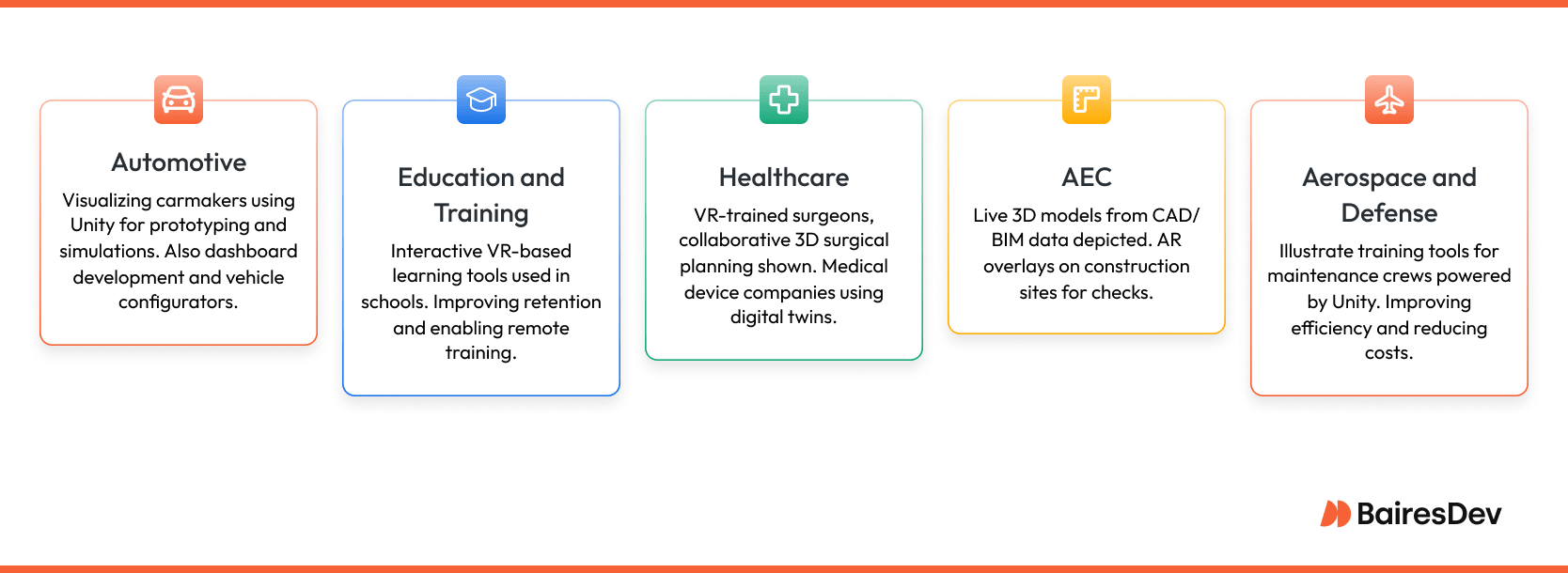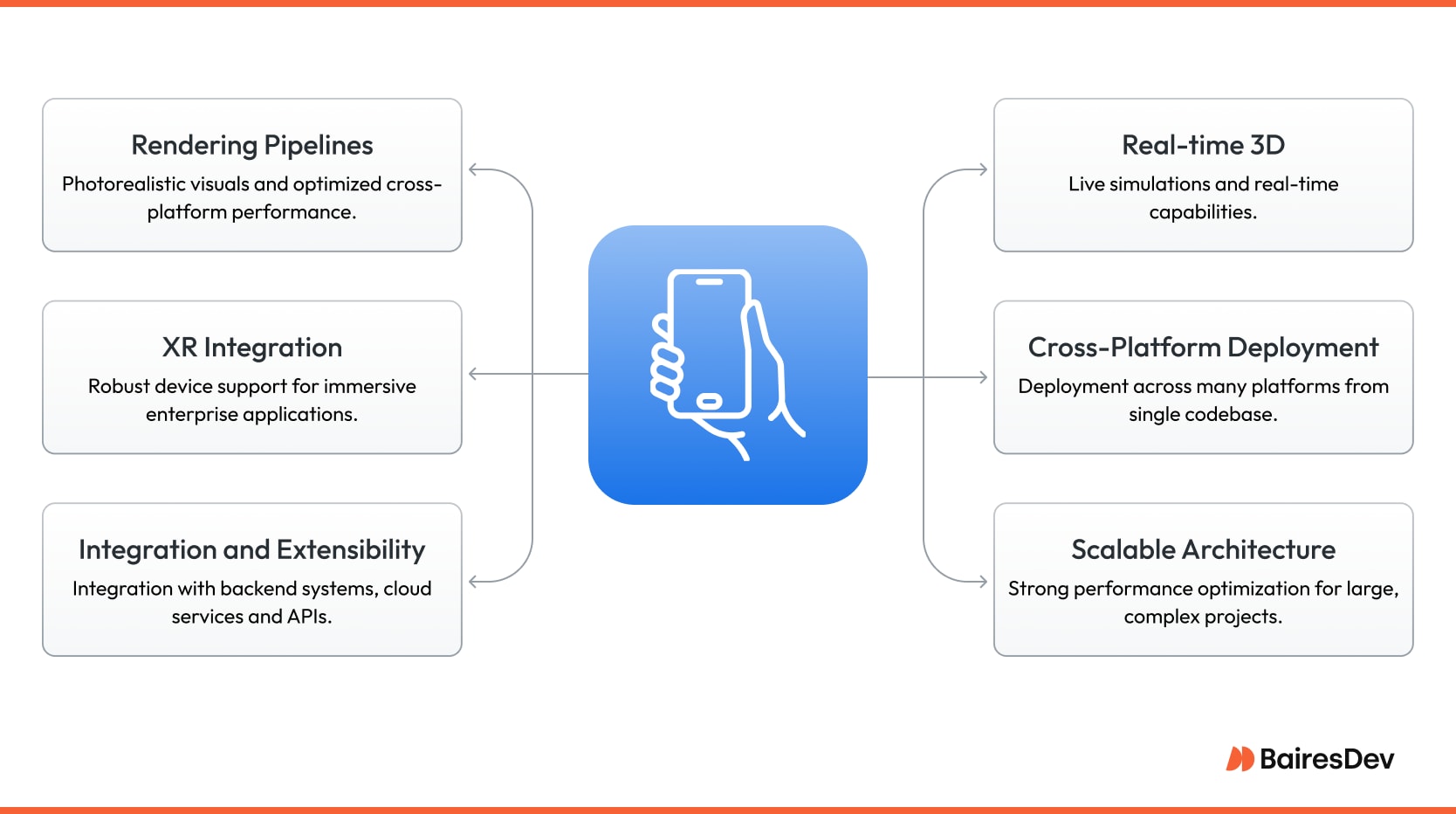Unity isn’t just a game engine anymore. It’s a cross-platform development environment that enables companies to deliver immersive, interactive experiences at scale. Originally built for game development, Unity is now used across industries such as automotive, healthcare, architecture, education, and media.
What is Unity used for?
Unity powers virtual prototyping tools, advanced simulations, virtual reality and augmented reality experiences, and much more. While known for games, Unity’s flexibility makes it the go-to platform for industrial and enterprise projects.
The professional AR and VR market is booming. Fortune Business Insights expects the XR market to reach $184B in 2024 and grow to $1.7T by 2032. Much of this growth comes from non-gaming use cases.
Industries driving adoption include major retail brands like Amayon and Walmart, along with automotive leaders such as Hyundai and Harley-Davidson.
Volvo runs mixed-reality driving tests in Unity to replicate real-world road conditions and test vehicle safety systems. Cincinnati Children’s Hospital uses Unity to develop a VR surgical planning platform that connects specialists worldwide. Architecture firms use Unity Reflect and VisualLive to create 3D building models that reveal design issues before construction starts.
The list goes on.
Industrial applications of Unity
Here’s how different sectors are putting Unity to work, to speed up research, train professionals, and create new experiences for their consumers.

Automotive
It could be argued that carmakers lead non-gaming Unity adoption. They use Unity for prototyping, dashboard development, safety testing, and consumer-facing vehicle configurators.
Healthcare
Studies show that VR-trained surgeons and technicians make fewer errors and complete procedures faster than counterparts trained using traditional methods. Hospitals use Unity-based collaborative platforms for remote surgical planning, while medical device firms apply use digital twins to improve design and reduce prototyping costs.
Architecture, Engineering, and Construction (AEC)
AEC firms import CAD/BIM data into Unity to create live 3D models for design review and clash detection. Augmented reality overlays on job sites help field crews verify installations, while Unity Reflect helps speed up review and approval cycles.
Aerospace and defense
Unity is used to power various simulators and support training programs. While it won’t replace dedicated flight simulators used by militaries and airlines, it can help train maintenance crews. This might not sound as glamorous as pilot training, but it can greatly improve efficiency and reduce costs.
Education and training
Schools and companies use Unity to build interactive learning tools. Studies have found that VR simulations can help improve retention compared to traditional teaching methods. Businesses also save costs by delivering specialized training remotely, e.g., VR allows them to offer highly specialized training to employees around the globe.
Unity talent pool and developer experience
But what about talent? That is where Unity’s gaming roots pay dividends. Unity’s popularity ensures a large, experienced talent pool. More than 5 million developers worldwide work with Unity, many transitioning from games to industrial applications.
According to Statista, the gaming market in the USA alone is projected to surpass 65.49 billion dollars (and that’s down from a record 66.88 billion in 2020). Gaming is a huge industry, one your business could benefit from, even if your primary focus isn’t games.
Unity Technologies, the company behind the Unity game engine, emphasizes its cross-platform capabilities and broad application in various industries beyond gaming, such as film, automotive, and architecture. With growing access to Unity-certified training programs and industry-specific training, enterprises can tap into an expanding talent pool ready to build the next wave of immersive, real-time solutions.
Supporting features
Beyond the talent pool, Unity offers several practical development advantages.
The engine provides robust tools via the Unity Editor, allowing engineers to debug systems interactively during runtime. Profiling tools offer insights into performance CPU, GPU, and memory bottlenecks, helping teams pinpoint issues and tune performance before deployment.
The WebGL build option allows businesses to create browser-based applications that don’t require users to install native clients. This is obviously extremely appealing for customer-facing applications. The WebGL pipeline is optimized to ensure near-native performance.
The technical advantages of Unity
Unity stands out thanks to its performance, scalability, and flexibility.
Unity provides a unified environment that accelerates development while ensuring reliability at scale. Its mature plugin ecosystem, strong cross-platform support, and enterprise-specific offerings make it a compelling choice for organizations creating XR solutions.

In the sections below, we’ll break down the key technical components that make Unity an enterprise-ready platform.
Advanced rendering pipelines
Unity’s rendering architecture gives users the flexibility to deliver photorealistic visuals and highly optimized cross-platform experiences.
- The High Definition Render Pipeline (HDRP) is designed for top-tier visual fidelity, making it ideal for automotive visualizations, architectural walkthroughs, or cinematic simulations.
- The Universal Render Pipeline (URP) balances performance and quality, enabling scalable deployment across devices from high-end workstations to mobile and embedded systems.
This flexibility allows companies to tailor visual quality to their target platforms without rebuilding assets.
Real-Time 3D and Digital Twin Support
Engineering teams can import CAD and BIM data directly into Unity for live 3D reviews, while manufacturing and energy companies use Unity to visualize operational data in real time. Teams can easily simulate airflow in a new building, model factory floor layouts, or run scenario testing. This accelerates design cycles, improves decision-making, and helps keep costs down.
AR, VR, and XR Integration
Unity offers good support for devices like HoloLens, Magic Leap, Varjo, Oculus, and HTC Vive. Unity’s consistent development environment and plugin ecosystem make it easier to integrate XR solutions into existing workflows, helping teams build immersive solutions faster.
Cross-Platform Deployment
One codebase can target more than 20 platforms, including desktop computers (Windows, macOS, Linux), mobile devices (iOS, Android), and AR/VR headsets.
This cross-platform agility reduces development time and maximizes reach. Unity’s Cloud Build tools streamline continuous integration and delivery (CI/CD), helping teams manage complex deployment pipelines efficiently across various hardware platforms and operating systems.
Integration and Extensibility
Unity’s open architecture makes it highly extensible for business use. Companies can integrate Unity applications with backend systems, cloud services, IoT platforms, and custom APIs, ensuring seamless data exchange and workflow integration.
The Unity Asset Store and Verified Solutions program provide access to a rich ecosystem of third-party tools, while Unity’s own enterprise offerings, such as Unity Industry and Unity Reflect, deliver tailored features for different industries.
Scalability and Performance
Unity handles large assets and real-time interactions efficiently, using advanced memory management and runtime optimization. Cloud integration enables scalable back-end processing.
Performance tuning in Unity is supported by robust profiling tools, giving development teams granular visibility into CPU, GPU, and memory usage across platforms. Critically, Unity supports incremental scaling, allowing enterprises to start with small pilot projects and scale with confidence.
Unity’s Strategic Approach to Business Applications
Unity Technologies is making focused moves to expand into enterprise XR solutions. This shift is driven by targeted product offerings, acquisitions, and partnerships that strengthen Unity’s value proposition.
Specialized enterprise offerings
Unity Industry delivers tools and services designed for industrial use, including enhanced CAD support, cloud simulation builds, and security features. Unity Reflect integrates BIM/CAD workflows with real-time visualization. Verified Solutions ensure compatibility with enterprise-grade tools.
Strategic acquisitions
Unity acquired VisualLive (AR construction tools) and Pixyz (CAD data optimization) to improve industrial workflows. Its $1.6 billion purchase of Weta Digital’s VFX tools extends its reach into media and content creation.
Technology partnerships
Unity partners with Autodesk to integrate CAD/BIM data, works with cloud providers like AWS and Azure for scalable simulations, and collaborates with hardware leaders like Varjo to ensure high-quality XR solutions. Unity also participates in standardization efforts through the XR Association and Khronos OpenXR initiative.
Implications
For business leaders, Unity offers a mature platform that can speed up product design, improve collaboration, and enhance training, all while tapping into a large pool of skilled developers. Unity’s strategic investments position it as a serious player in enterprise innovation.
Unity Technologies is signaling that its technology can be used to do more than create games. It can accelerate product design cycles, enhance global collaboration, improve training outcomes, and create new forms of customer engagement.






